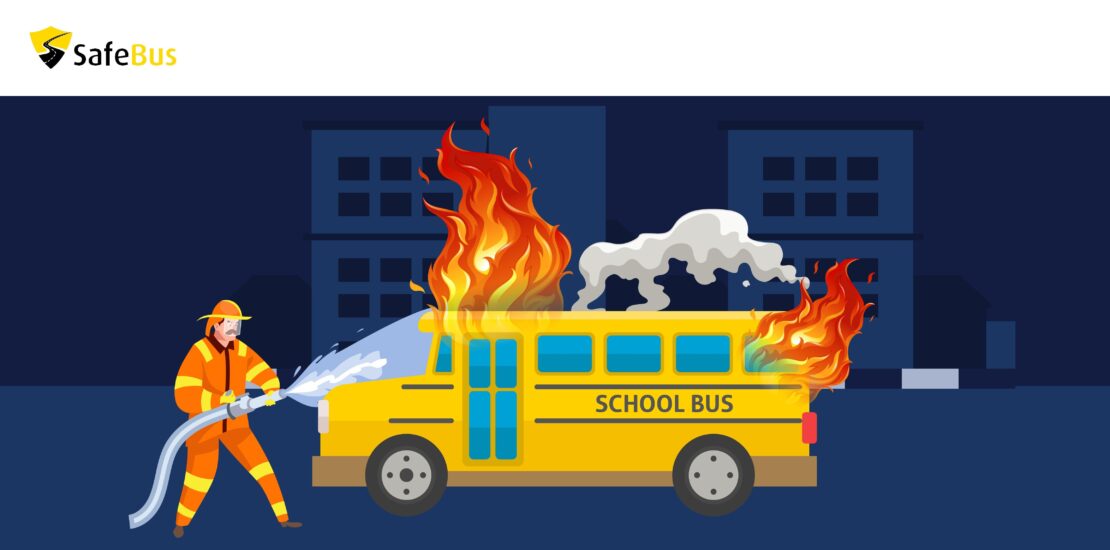- March 30, 2021
- Posted by: Satvir
- Category: Blog

The school bus is one of the safest means of transportation available to schoolchildren across the US and, yet, that distinction does not mean that it is completely immune to safety-related issues. Take accidental fires, for instance, that can be caused by anything, ranging from a mechanical breakdown to engine overheating and fuel leaks.
The instances of school buses catching fire, thankfully, are infrequent enough and very rarely do result in severe bodily harm or fatality. However, it falls upon the school administration to ensure that students remain well-protected in case of such a mishap by defining contingency plans that can be deployed to limit its impact. These measures can be divided into three broad categories, as follows:
On-ground evacuation, management, and containment
The most critical step, in case of a fire, is the immediate response. Panic and confusion of the initial moments can often exacerbate the situation, which is why drivers and bus attendants must act decisively and swiftly to assume control with a calm, assuring presence. If possible, it is advisable to stop the bus in a safe area away from the on-road traffic.
Here are the road safety tips for school children
The evacuation that follows must be orderly and calm. Elder students can be charged with the responsibility of guiding their younger peers to the nearest exit, as well as moving them to a safe distance from the vehicle, under the supervision of an adult staff member. In urgent cases, students must be advised to leave behind their belongings. The driving staff must be the last to disembark and must endeavor to retrieve the first-aid kits and fire extinguishers available in the vehicle.
The next step for the driving staff is to ensure that every child has safely disembarked and is accounted for. While this has conventionally been done through physical checklists, new age fleet management apps such as SafeBus come with digital student rosters that can optimize this step for speed and accuracy.
Click here to know the role of technology in school bus safety
These actions must be taken even if there is the slightest suspicion of fire or smoke in the bus; the safety of the students, after all, is of the utmost importance here. Once students are safely evacuated, the staff can turn their attention to containing the fire. On their part, school administrations can improve their emergency response by conducting regular fire drills and training for both the students and the in-vehicle staff.
Centralized remediation
After containing the on-ground situation, the next course of action is to notify the transport admin team at the school to make alternative transport arrangements. This can be done by either calling the dispatch or by raising a soft SOS alert on the digital fleet management app. The transport team, once it receives the alert on the centralized console, can dispatch an alternate vehicle to take school kids home.
Schools that leverage digital fleet management solutions are at an advantage in this case. Why? Because the transfer process is more streamlined and hassle-free, while the details of the newly assigned vehicle and driver are updated immediately on the parent-facing apps, who are also notified through app-based and SMS alerts. This transparent and proactive provision of information addresses any concerns that parents might have, providing some relief from the stress and worry that they undoubtedly feel after the incident.
Post-event forensics, analysis, and deterrent
Even if the fire is contained with no injury or harm, the chances of it occurring again can and must be minimized. While such fires are typically caused by overheating or mechanical failure, the possibility of intentional tampering or leaks cannot be discounted. Understanding the cause behind the fire can help the school administration avoid such occurrences in the future. Conducting a detailed post-event analysis, therefore, is a must.
Schools can also utilize digital fleet management solutions such as SafeBus to implement automated checklists to manage and track vehicle maintenance schedules as well as the in-vehicle inventory of essential safety equipment such as fire extinguishers and first-aid kits. This not only ensures that the fleet used for student transportation is at a reduced risk of a mechanical breakdown but is also well-equipped to deal with any unforeseen emergency.
As with anything mechanical, there is always the possibility that school buses, despite the measures taken, might still break down. Implementing these measures, however, minimizes the possibility of an unforeseen situation occurring while also empowering the driving staff with the tools and knowledge they need to ensure the safety of students in such an event.
After all, adequate preparation is half the battle won.
